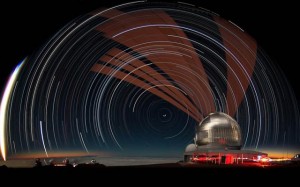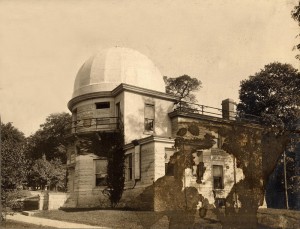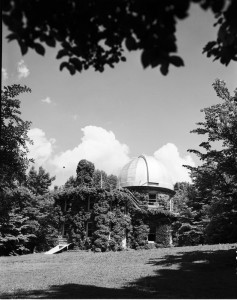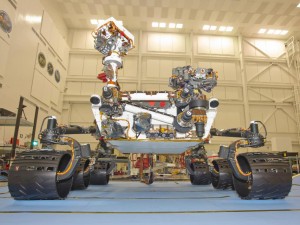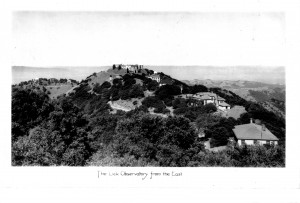The June edition of the alumni magazine from (one of) my undergrad institutions arrived in the mail on Thursday. The last inside page (scroll to the bottom of the linked .pdf) was dedicated to a photo of the 6″ refracting telescope in the Theodor Jacobsen Observatory on the campus of the University of Washington. We’ve been having a discussion about the digital manipulation of the sky viewed through the dome’s opening—while the bottom half of the sky does a good job of representing Seattle’s light pollution, the top half isn’t a particularly accurate rendering of the sky visible above the observatory. Even so, it’s a lovely view of the Warner & Swasey equatorial mount and the Brashear lens, as well as the Warner & Swasey wood dome.*
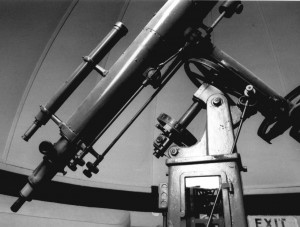
Refracting Telescope, Warner & Swasey Equatorial Mount. Image credit: University of Washington
Today, the observatory stands next to the campus gates at 45th and Memorial Way. While this part of campus remained undeveloped until the 1950s, by the time I was a student at UW in the 1980s, the woods had mostly been lost to (well-lit) parking lots. Possibly a few of the astronomy classes used the telescope for educational purposes until then, but mostly the observatory functioned for fifty years as a nice historical monument, the second oldest building on campus. Fortunately, the telescope was refurbished in the 1990s and just ten years ago, the astronomy department began using the observatory in its public outreach program.
The early astronomy program at University Washington had strong ties with the work being done at Lick Observatory, east of St. Jose, CA. Mathematics professor Joseph M. Taylor studied at Lick as a “special student” in 1890 and returned to UW to found the astronomy department in 1891. When the university moved from downtown Seattle to its present location, Taylor spent $3000 allocated to the department by the Regents on a 6″ refractor and a building in which to house it. The original wood frame observatory stood for only three years before Taylor started looking for a more permanent structure. In 1895, he appropriated the stone and money left over from the construction of nearby Denny Hall and directed it toward the construction of the masonry observatory we see on campus today.
The observatory is named after a later professor of astronomy, Theodor S. Jacobsen, who began teaching at UW in 1928. A graduate of UC-Berkeley, he worked as a Lick Observatory Fellow for two years after completing his Ph.D. Allegedly, he hurt his back moving the Great Refractor one night and decided to pursue a less physically risky career, like teaching astronomy and mathematics (although he continued his research on variable stars, so I’m not so sure about that story). At any rate, Professor Jacobsen had a long career at the university and afterward: his last book came out in 1999, four years before his death at the age of 102.
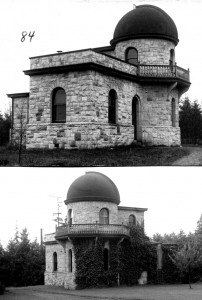
Theodor Jacobsen Observatory. Photo credit: University of Washington
The architecture of the observatory is well documented in the Historic Property Inventory Form submitted as part of the application process for inclusion on the State Register of Historic Buildings. Two choice passages:
“Built in 1894-95, this small, stone masonry building is the second oldest on the University of Washington campus. Charles W. Saunders, a leader of the architectural profession in Seattle during this era, designed this building as well as the first building on campus, Denny Hall, and the first gymnasium. Situated at the northern end of the central campus southeast of the NE 45th Street entrance, the observatory was built with stone remaining from the construction of Denny Hall, using surplus funds from that earlier project. The telescope dome sits on top of a two-story tower at the north end of a one0story building with flat roofline and a rectangular plan. Supported by large wooden brackets, a shallow wooden balcony with a low wooden balustrade encircles the northern half of this tower at the second story, ending at a small, enclosed stairwell on the west elevation. Built with roughly cut stone set in broken courses, the structure features segmentally arched door and window openings with radiating voussoirs reminiscent of the Romanesque Revival style. The windows appear to retain their original wooden sash units. Sheathed in sheet metal, the telescope dome rotates on cannon balls left over from the Civil War** and still houses the original six-inch clear-aperture telescope. Well-maintained with good physical integrity, the observatory continues to hold free public showings on selected clear nights with slide shows given on other evenings.”
“Charles W. Saunders initiated his practice in Seattle shortly after the 1869 fire and remained among the leaders of the architectural profession for the next twenty years. After 1898, Saunders was in a sixteen-year partnership with George W. Lawton. Together, they designed an extraordinarily wide range of projects executed in an eclectic variety of styles, including schools, residences, apartments, and commercial buildings as well as several buildings for the 1909 Alaska-Yukon-Pacific Exposition. Lawton had also come to Seattle in 1889 and had worked for Saunders before entering into partnership with him.”
*If you’re counting, this makes the fifth Warner & Swasey telescope I’ve discussed recently; see the entries for the Lick, Kirkwood, Yerkes and University of Illinois observatories for the other four.
**Similar to the rotating mechanism in use at the Cincinnati Observatory Centre
